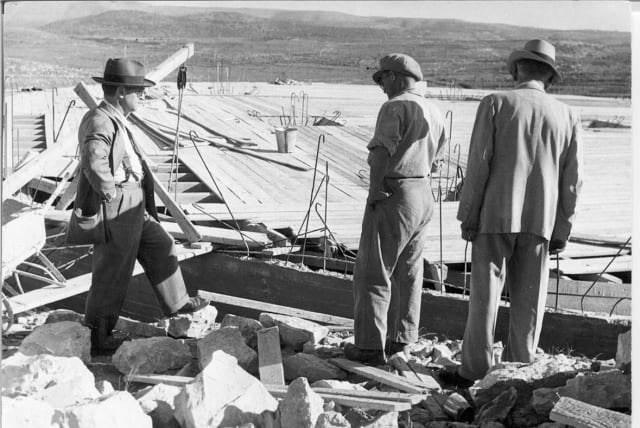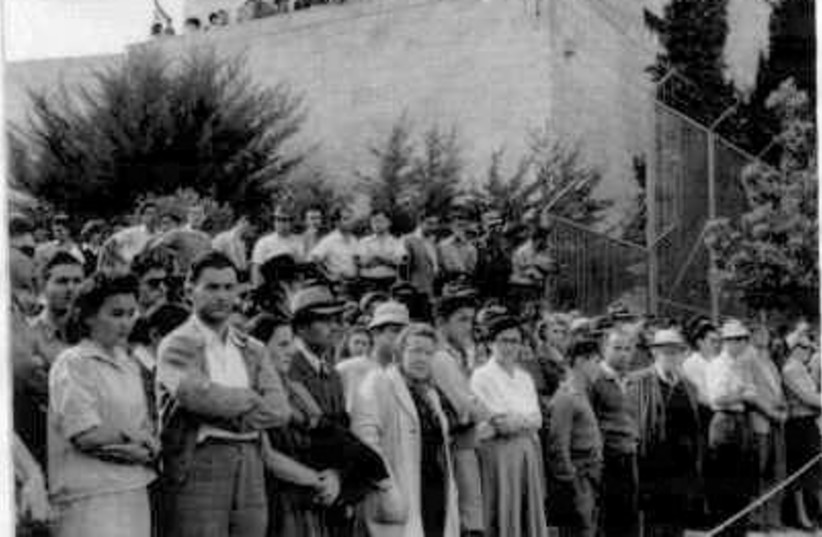Remembering Israel's fallen heroes who died defending Kfar Etzion

Two young men from South Africa couldn't be more different. But they both died together in Kfar Etzion fighting for Israel.
This is a story of two young men who could not have been more different.
Yechezkel (“Chatsi”) Berelowitz, born in 1918, was the eldest of six sons and two daughters. Tzvi Lipschitz, born in 1921, was the youngest of three. While Berelowitz was born and lived all of his formative years in Johannesburg, Tzvi, who was born in Ukraine, had a nomadic childhood, as his family immigrated to Lithuania and then to Johannesburg.
Lipschitz, whose mother tongue was Yiddish, was a fierce, uncompromising idealist who expected the highest standards of idealism from himself and his peers. He was a leader by example, a fiery, charismatic orator steeped in Jewish texts. In contrast, Berelowitz was a laid-back, genial soul whose favorite activity was landscape gardening. He led by a gentle hand and by suggestion rather than by command.
When they met for the first time in the late 1930s, it was in a dingy back room of a house in Doornfontein. This lower-middle-class suburb was home to the many Eastern European Jewish immigrants who had fled the pogroms and poverty of the Pale of Settlement for the promise of South Africa.
This modest room was the hub of the fledgling South African branch of the Hashomer Hadati youth group, which later morphed into the modern Bnei Akiva movement. Despite their distinctly different personalities, Berelowitz and Lipschitz shared a passion for Religious Zionism and a resolve to practice what most others simply preached at that time. Both were determined to go to Palestine to play their part in the establishment and development of the Jewish homeland.
In 1944, Berelowitz was the first to make the long, arduous trip to Palestine, by air, sea and land. And he had a very specific destination. For in that Doornfontein room hung a portrait of Avraham Katz.
Katz had been the first oleh of the movement, arriving in Eretz Yisrael in 1935. There, he had joined Kvutsat Avraham – a group of young religious men and women, mainly from Eastern Europe, who had gathered in a common cause on a hill outside of Kfar Pines. They learned agricultural skills and self-defense in preparation for establishing their own settlement.
In 1938, volunteers were needed to help establish and secure Kibbutz Hanita, a Tower and Stockade kibbutz on the Lebanese border surrounded by hostile Arab villages. Katz signed up with alacrity.
It was there that Katz was shot and mortally wounded by Arab marauders while on guard duty. He lingered for five weeks in a Haifa hospital. His last words are said to have been: “Take me back to Hanita. My place is there.” His funeral was attended by hundreds, and he became a legend and hero for the Religious Zionist youth, both in Palestine and South Africa, including Berelowitz and Lipschitz.
Arriving at Kfar Etzion
THUS BERELOWITZ was determined to join Kvutsat Avraham on his arrival in Palestine. By then, the group had realized its dream. It had been commissioned to create a new settlement called Kfar Etzion, situated on the road that runs south of Jerusalem, between Bethlehem and Hebron. This was the heartland of biblical Israel, which our forebears passed through, where Rachel was buried, and King David tended his sheep. Undeterred by the rocky, infertile land, hostile surroundings, and two previous failed attempts, these young men and women were determined to renew their connection to the Jewish people by way of their toil and sacrifice.
Within a year, Lipshitz had joined Berelowitz, and they immersed themselves in the building of the settlement. Typically, Lipshitz was engaged in the practicalities. Having prepared himself for the tasks ahead, he designed and directed the building of the water supply and sewage systems. Berelowitz was commissioned to landscape the living areas and Beit Ovadia, a retreat center created for artists, musicians and literary figures in the Yishuv. He even solicited funds from the South African Jewish community, naming a hall in the retreat Ulam Avraham, after his role model.
By 1947, both young men had developed reputations for diligence and excellence and were in demand for other assignments. Lipschitz rejected a rabbinic career and an offer to be an emissary in the US in favor of the agricultural trenches of the fledgling community.
Berelowitz was sent to train a group of South African olim who had been sent to help establish Kibbutz Ein Hanatziv in the Jordan Valley. He then accepted an invitation to return to South Africa to train potential olim for agricultural life in the Yishuv. To secure the necessary papers, he had to spend time in Jerusalem, and decided to take the opportunity to stay at his beloved Kfar Etzion kibbutz, not far from the city. It was December 1947, and with the UN approval of the Partition Plan, the local Arabs had become increasingly more violent. And so Berelowitz changed his plans.
He wrote to his friends, “I have invested three years of labor in this place. Every stone and every corner is saturated with sweat here. I am tied to the people. I cannot leave them right now, when they stand under siege and in solitude. Every hand is needed here now.
“But I hope all this will pass quickly and we will return and we’ll see each other. Permission was given to me to leave. Why did I come here, if not to fulfill such tasks? Forgive me, friends, for staying with the besieged.”
AND SO Lipshitz and Berelowitz, who both could have left the kibbutz for the most legitimate of reasons, chose to remain there despite the mortal danger. The situation became increasingly more precarious with a siege laid on the kibbutz and its three sister settlements, which were collectively called the Etzion Bloc. Attempts were made to break the blockade, among them the famous Lamed Hey and Neveh Daniel convoys, in which so many young lives were lost. Thought was given to abandoning the settlement, but the bloc was the sole Jewish presence that stood between the Jordanian army and local militia, and Jewish Jerusalem.
On April 24, 1948, Lipschitz wrote to his parents, “With the arrival of Passover, we again await the ‘Time of Freedom’ as our elders did hundreds of years ago. A long and bloody road stands before us. My personal wish to you, my dear parents, is that next Passover, you will be with me in a liberated and safe Eretz Yisrael. Your beloved son, Tzvi.”
Nineteen days after writing these words, both Lipschitz, aged 27, and Berelowitz, 30, fell in action alongside 127 men and women in the final battle of Kfar Etzion and the ensuing massacre by Arab irregulars and Jordanian Legion troops. Berelowitz was shot as he ran between positions to deliver commands. Lipschitz was killed at his guard post.
The very next day, David Ben-Gurion declared the founding of the State of Israel, to which the two men had so passionately aspired.
Ben-Gurion eulogized the defenders and their heroic stand. “I can think of no battle in the annals of the Israel Defense Forces that was more magnificent, more tragic or more heroic than the struggle for Gush Etzion. If there exists a Jewish Jerusalem, our foremost thanks go to the defenders of Gush Etzion.” The memory of those who fell in the battle for Gush Etzion is marked on Remembrance Day.
These two young men died in battle before they could marry and create a family. But Berelowitz wrote letters to his friends, which they lovingly passed on to their own children. And 70 years after Lipshitz’s passing, 108 letters written in Yiddish to his family from Kfar Etzion were discovered in his great-niece’s storeroom. They were translated into English by family friend Eileen Zackheim-Friedman. These precious documents illustrate the two pioneers’ very different personalities and the heroic roles they played in the establishment of the modern Jewish state.
As we celebrate the 75th anniversary of the fulfillment of the ancient, unimaginable dream of the State of Israel, it is our obligation and honor to remember Berelowitz, Lipshitz and the thousands of men and women who sacrificed themselves in its fulfillment and preservation. ❖
The writer thanks the Gush Etzion Heritage Center, Ora Rottenberg, and Eileen Zackheim-Friedman for their assistance.
Jerusalem Post Store
`; document.getElementById("linkPremium").innerHTML = cont; var divWithLink = document.getElementById("premium-link"); if (divWithLink !== null && divWithLink !== 'undefined') { divWithLink.style.border = "solid 1px #cb0f3e"; divWithLink.style.textAlign = "center"; divWithLink.style.marginBottom = "15px"; divWithLink.style.marginTop = "15px"; divWithLink.style.width = "100%"; divWithLink.style.backgroundColor = "#122952"; divWithLink.style.color = "#ffffff"; divWithLink.style.lineHeight = "1.5"; } } (function (v, i) { });

